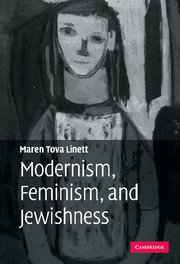Book contents
- Frontmatter
- Contents
- Acknowledgments
- List of abbreviations
- Introduction: imagined Jews and the shape of feminist modernism
- 1 “Strip each statement of its money motive”: Jews and the ideal of disinterested art in Warner, Rhys, and Woolf
- 2 Transformations of supersessionism in Woolf and Richardson
- 3 Adding bathrooms, fomenting revolutions: modernity and Jewishness in Woolf and Warner
- 4 The race must go on: gender, Jewishness, and racial continuity in Barnes and Richardson
- 5 The “No time region”: time, trauma, and Jewishness in Barnes and Rhys
- 6 Metatextual Jewishness: shaping feminist modernism
- Notes
- Works cited
- Index
3 - Adding bathrooms, fomenting revolutions: modernity and Jewishness in Woolf and Warner
Published online by Cambridge University Press: 22 September 2009
- Frontmatter
- Contents
- Acknowledgments
- List of abbreviations
- Introduction: imagined Jews and the shape of feminist modernism
- 1 “Strip each statement of its money motive”: Jews and the ideal of disinterested art in Warner, Rhys, and Woolf
- 2 Transformations of supersessionism in Woolf and Richardson
- 3 Adding bathrooms, fomenting revolutions: modernity and Jewishness in Woolf and Warner
- 4 The race must go on: gender, Jewishness, and racial continuity in Barnes and Richardson
- 5 The “No time region”: time, trauma, and Jewishness in Barnes and Rhys
- 6 Metatextual Jewishness: shaping feminist modernism
- Notes
- Works cited
- Index
Summary
In his analysis of antisemitism and modernity, Zygmunt Bauman writes that Jews, more than other groups, were “vulnerable to the impact of new tensions and contradictions which the social upheavals of the modernizing revolution could not fail to generate. For most members of society, the advent of modernity meant the destruction of order and security; and … Jews were perceived as standing close to the center of the destructive process.” Bauman is referring to modernity more broadly, but his points apply well to interwar British and American culture. In the first half of the twentieth century, Jews were often viewed as moderns par excellence. Like modernity itself, they were seen as cosmopolitan, rootless, and urban. They were perceived as instrumental to whatever social-financial system seemed especially modern, whether mass market capitalism or revolutionary socialism. In his study of Freud, Germanness, and Jewishness, Peter Gay proposes that antisemitism was motivated by a fear of modernity:
Whatever else it was, German anti-Semitism was a way of confronting – or, rather, not confronting – the pressures of contemporary life […]: specialization, mechanization, the crowding in of impulses and the speeding up of existence, the burgeoning threats posed by Godless morality, Socialist revolution, and cultural nihilism; anti-Semitism was, in short, an irrational protest against the modern world.”
- Type
- Chapter
- Information
- Modernism, Feminism, and Jewishness , pp. 80 - 110Publisher: Cambridge University PressPrint publication year: 2007



